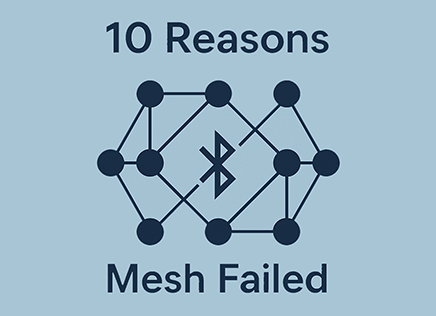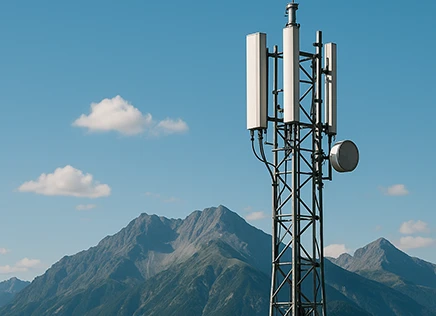A new Long-Range, Low-Power Wi-Fi Standard
As the Internet of Things (IoT) continues to expand into smart cities, agriculture, healthcare, and industrial automation, the demand for reliable long-range wireless connectivity has never been greater. Wi-Fi HaLow enters the picture as new potentially game-changing wireless standard designed to meet the needs of devices that require extended range, low power consumption, and strong security.
What Is Wi-Fi HaLow?
Wi-Fi HaLow is the Wi-Fi name for a new standard based on IEEE 802.11ah. It’s a subset of the Wi-Fi family specifically designed for IoT and M2M (machine-to-machine) communications.
Unlike traditional Wi-Fi that operates in the crowded 2.4 GHz, 5 GHz and 6GHz bands, Wi-Fi HaLow uses Sub-1 GHz frequencies (typically in the 750 MHz to 928 MHz range). The lower frequency helps HaLow deliver superior range and better wall penetration.
Wi-Fi HaLow was developed by the Wi-Fi Alliance, and it combines familiar IP-based networking with optimizations for low-power, long-range scenarios — a compelling alternative to protocols like Zigbee, LoRaWAN, or Bluetooth LE in certain use cases.
Key Features of Wi-Fi HaLow
- Long Range:
Thanks to its Sub-GHz operation, HaLow can reach up to 1 kilometer in open environments — significantly farther than conventional Wi-Fi. Its signals also penetrate walls and obstacles more effectively, making it ideal for industrial, agricultural, and large building deployments. - Low Power Consumption:
Designed with battery-powered sensors and edge devices in mind, HaLow supports power-saving modes similar to those in Bluetooth LE and other IoT-specific technologies. Devices can remain in sleep mode and wake periodically, extending battery life to years in some cases. - High Scalability:
A single HaLow Access Point (AP) can support thousands of devices, which is vital for dense IoT deployments such as smart farms, factories, or urban infrastructure. - IP-Native and Secure:
HaLow supports a full TCP/IP stack communication, making integration with existing internet services straightforward. It also features strong WPA3-grade encryption and authentication mechanisms, offering enterprise-grade security. - Flexible Data Rates:
Wi-Fi HaLow supports data rates from 150 Kbps to 80Mbps, allowing it to cater to both lightweight sensors and more demanding use cases like video surveillance or industrial automation.
Wi-Fi HaLow vs. Other Wireless IoT Technologies
| Feature | Wi-Fi HaLow | LoRaWAN | Zigbee | Bluetooth LE |
|---|---|---|---|---|
| Frequency Band | Sub-1 GHz | Sub-1 GHz | 2.4 GHz | 2.4 GHz |
| Range | Up to 1 km | Depending on modulation. 15 km | ~10–100 m | ~10–400 m – More with High Output power and LE Long Range |
| Power Efficiency | High | Very High | High | Very High |
| Data Rate | Up to 80 Mbps (4 spatial streams), usually ~15Mbps | <50 Kbps | ~250 Kbps | Up to 2 Mbps |
| Native IP Support | Yes | No | No | Partial |
| Network Size | Thousands | Thousands | Hundreds | Dozens-Hundreds |
Wi-Fi HaLow strikes a unique balance — it isn’t as long-range or low-bandwidth as LoRaWAN, nor as high-speed as traditional Wi-Fi, but it offers enough of both to stand out in many applications. For example some of the applications we’ve seen Wi-Fi HaLow make an appearance are video baby monitors – HaLoW provides enough throughput for video while providing whole home coverage.
Applications of Wi-Fi HaLow
- Smart Agriculture: Connecting sensors across vast fields for monitoring soil moisture, livestock movement, and climate conditions.
- Industrial IoT (IIoT): Supporting low-latency communication for predictive maintenance, robotics, and factory automation.
- Smart Homes and Buildings: Integrating cameras, smart locks, thermostats, and sensors that need robust connectivity and low power.
- Healthcare: Enabling wearables and remote patient monitoring systems to transmit data securely and efficiently.
- Smart Cities: Powering infrastructure such as smart parking, waste management, and public safety sensors.
Market Outlook and Ecosystem
Wi-Fi HaLow is still in the early stages of adoption, and Companies like Morse Micro and Newracom are the two main companies providing HaLow chipsets at the moment.
As certification grows and costs drop, it is expected to become a cornerstone in IoT infrastructure by offering a more seamless path to Wi-Fi integration than many low-power wireless alternatives.
HaLow Challenges
One of the main challenges for current HaLow is that there’s too few vendors developing chipsets and they’re relative newcomers. This means that chipsets have taken longer to develop the right performance levels. Many of the chipsets have higher power consumption which limits them from battery powered products.
Morse Micro entered the market with its MM6108 chipset which didn’t support 256-QAM modulation and where power consumption was relatively high. For example in DTIM3 it consumes 390uA.
Morse recently released its MM8108 chipset which is smaller and more capable. It adds 256-QAM and MCS 8/9 support, and enables up to 23Mbps and 30Mbps for TCP/UDP. There’s significant improvements in power consumption, with various modes like RX, TX and sleep experiencing around 30% lower power, sometimes much less.
HaLow PHY Layer
The lowest level of any wirleless system is the physical layer, commonly called PHY, which translates data bits into a modulated signal. As we mentioned before, Wi-Fi Halow uses the 750 MHz to 928 MHz range, though 863-868 MHz are used in Europe while 902-928MHz is used in the US.
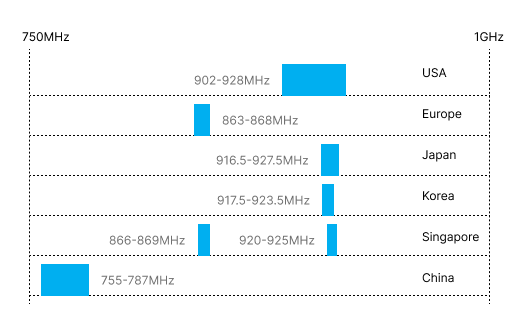
HaLow has to deal with the Sub-1GHz band in each country. The figure above shows the band allocations for various countries including:
- USA – 902MHz – 928MHz – 26MHz
- Europe – 863MHz – 868MHz – 5MHz
- Japan – 916.5MHz – 927.5MHz – 11MHz
- Korea – 917.5MHz – 923.5MHz – 6MHz
- Singapore – 866-869MHz and 920-925MHz – 3MHz and 5MHz
- China – 755-787MHz – 32MHz
One of the challenges in designing products with HaLow that have global support is that difference in bands means that designing antennas and matching networks that globally is not easy, and different product SKUs are likely necessary. It’s typical that impedance matching that covers all bands and 173MHz will sacrifice performance overall, whereas impedance matching for narrow bands of around 30MHz are much easier to achieve. Typically this means products for 900MHz, 868MHz and 755MHz bands would be separate, or you could try and cover 868MHz to 928MHz which is easier.
The Sub-1Ghz band has a few advantages over 2.4GHz and others including:
- Better propagation due to the physics of a lower frequency
- Improved penetration of walls
- No licensing – similar to 2.4GHz
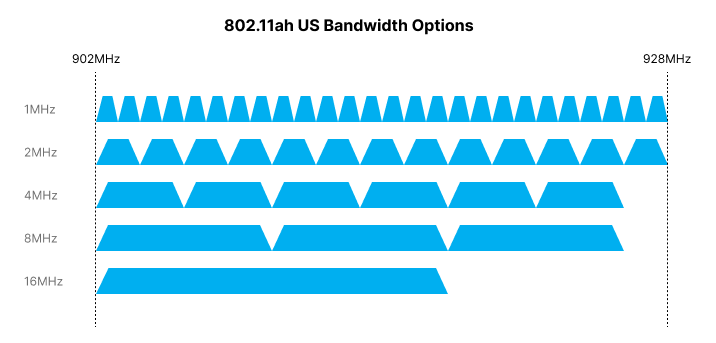
802.11ah enables the channel bonding features that became standard in 802.11n and 802.11ac. In the relatively wide US spectrum of 26MHz. There’s a few other aspects that the 802.11ah standard used from 802.11ac aside from the channel bonding. The Subcarrier bandwidth is 1/10th of the same in 802.11ac, so 40MHz in 802.11ac is 4MHz in 802.11ah.
1MHz and 2MHz bandwidth is mandatory for stations while 1MHz, 2MHz and 4MHz are mandatory for Access Points.
- Spatial Streams (NSS): 1 to 4 spatial streams
- Generation modes: S1G, NDP for sounding, NDP for NDP MAC
- PPDU format: S1G_1M, S1G_SHORT, and S1G_LONG
- MCS index: MCSs 0 to 9, and MCS10 for 1 MHz only
- Binary convolutional coding
- Low Density Parity Check (LDPC)
- Space Time Block Coding (STBC)
- Short Guard Interval (Short GI)
- Up to 4 multiple users
- Aggregated MPDU
- Fixed and Traveling Pilots to help with moving stations
Like 802.11 Wi-Fi, HaLow uses a variety of modulation and coding schemes (MCS) including BPSK, QPSK, 16-QAM, 64-QAM, and 256-QAM. This allows the ability to adjust throughput depending on the range. You can enable longer ranges by using lower throughput , or go higher throughput when the signal levels are high enough. Higher modulation formats like 256-QAM require better signal and only work at shorter ranges.
HaLow has very broad PHY rates, from 150kbps to 347Mbps if you use the highest modulation and 4 streams.
HaLow builds on well known and proven wireless technologies. It uses Orthogonal Frequency Division Multiplexing Access or OFDM. What this means is that instead of transmitting one large signal with a large bandwidth, the device transmits many smaller modulated signals (called subcarriers) with smaller bandwidths that are orthogonal. Orthogonal means the signal peak happens at the minimum of adjacent signals, so there’s no interference.
You can see in the graph below the OFDM signals and how the peaks themselves don’t overlap. An OFDM signal uses multiple of these subcarriers depending on the total bandwidth. Each one of the subcarriers is modulated with the chosen MCS.
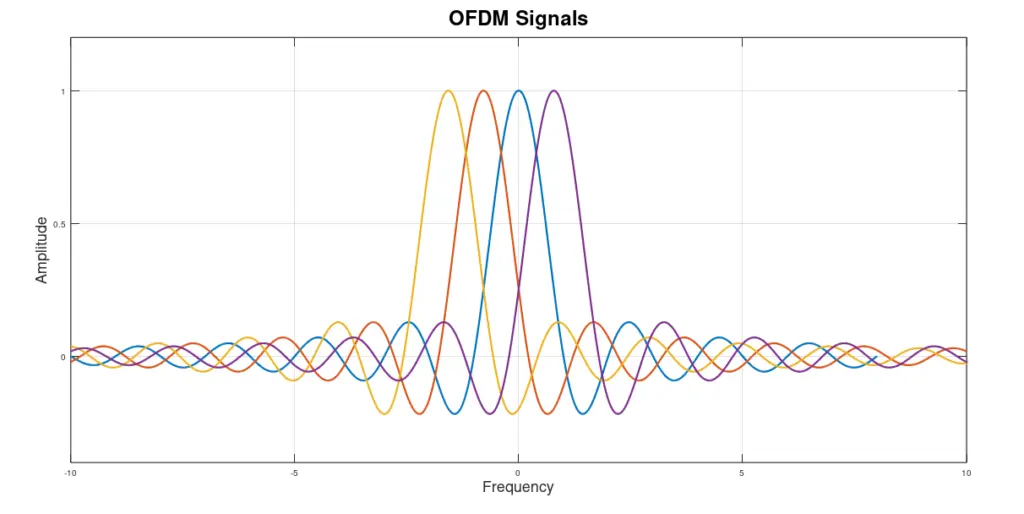
Leveraging OFDM has many benefits, including allowing flexible bandwidth allocation. OFDM allows one to adjust the total bandwidth and in the case of HaLow, that bandwidth can be, 1MHz, 2MHz, 4MHz, 8MHz and up to 16MHz which are 10x smaller than Wi-Fi. Compare this to 20MHz, 40MHz, 80MHz, 160MHz and 320MHz of standard Wi-Fi 802.11.
The reduced throughput is what enables HaLow’s to get longer range, but HaLow also has to work in the smaller 868MHz band in Europe where there’s less spectrum available.
Other advantages to OFDM include high spectral efficiency and robustness to interference and multipath – a single subcarrier being affected by noise can still allow data to be received successfully.
In essence, HaLow has taken the proven Wi-Fi technology and moved it to the Sub-1GHz band along with reducing the bandwidth to account for the smaller available spectrum.
The 802.11ah standard also includes advanced features like single-user beamforming and MIMO technologies, though in practice the current chipsets don’t include support for these features because of the complexity and the very specific use cases.
HaLow MAC Layer
One of the main goals of a Medium Access Control layer of 802.11ah (MAC Layer) is to control access to the (wireless) medium and allow thousands of devices to connect.
Like Wi-Fi, HaLow uses the concept of stations connecting to an Access Point. Because of this, HaLow is a point to point protocol.
There are three different station types in 802.11ah:
- Traffic Indication Map (TIM) Stations – the most common type because of their ability to sleep for long periods of time
- Non-TIM Stations
- Unscheduled Stations
Traffic Indication Map (TIM) Stations
The main aspect of TIM stations is that they listen to beacon packets sent by the Access Point. They use scheduled listen periods to check for buffered traffic at the Access Point (AP) and receive the TIM information element that indicates whether there is data available for the station. Rather than staying awake all the time, a TIM Station (or TIM STA) wakes up periodically based on a beacon schedule to determine if the AP has traffic for it.
Non-TIM Stations
Non-TIM stations don’t listen to beacons. Instead, when they first associate with the Access Point, they are allocated a periodic restricted access window (PRAW). This allows these type of stations to transmit periodically. Because of this behavior, non-TIM stations are used for high data applications where power is not a concern.
Unscheduled Stations
Like Non-TIM Stations, Unscheduled Stations don’t listen to any beacons. Instead they send a poll frame message to the Access Point asking for immediate access to the channel. The Access Point responds with a frame that tells the station the time slot in which it can transmit.
Massive TIM Station Support
Early versions of the 802.11 standard, up to and including 802.11n, were notoriously problematic as far as large device support. This has improved in recent standards like 802.11ac and 802.11ax.
For 802.11ah HaLow it was critical that the standard be able to support a large number of devices, ideally in the thousands, since the protocol would be used with devices such as a large deployment of sensors. These devices also had to be supported using TIM, because this is the lowest power mode and most HaLoW devices are likely to battery powered.
To solve the issue of supporting a large number of devices, 802.11ah uses a hierarchical approach that places stations in groups. Groups of devices can be configured to customize them depending on how they operate.
The hierarchy uses an Association Identifier (AID) that splits stations into pages, blocks, and sub-blocks. Because the AID is 13 bits, the maximum number of stations supported is 8191.
Because 802.11ah is an 802.11 amendment, it retains a lot of the standard networking protocols including TCP/IP and UDP/IP. This means that reusing existing protocols is much easier.
Data Transmission
One of the downsides of sensor data is that it tends to send relatively small packets. This means that a header for each packet is inefficient because it represents a significant number of bytes relative to actual data.
Because of this, one of the changes in 802.11ah was to cut down on the MAC header from 28 bytes to 18 bytes. One way to do this was to use an association identifier instead of a MAC address. There are also changes to the signaling frames and the ACK packet used.
Conclusion
Wi-Fi HaLow is poised to fill a critical gap in the wireless connectivity landscape — where traditional Wi-Fi 802.11 couldn’t operate due to power consumption and range limitations, 802.11ah offers long-range, low-power communication with the security, scalability, and IP-based compatibility of mainstream Wi-Fi. As the IoT ecosystem expands beyond homes and into vast industrial and outdoor environments, HaLow offers a robust and future-ready solution for next-generation wireless deployments.






